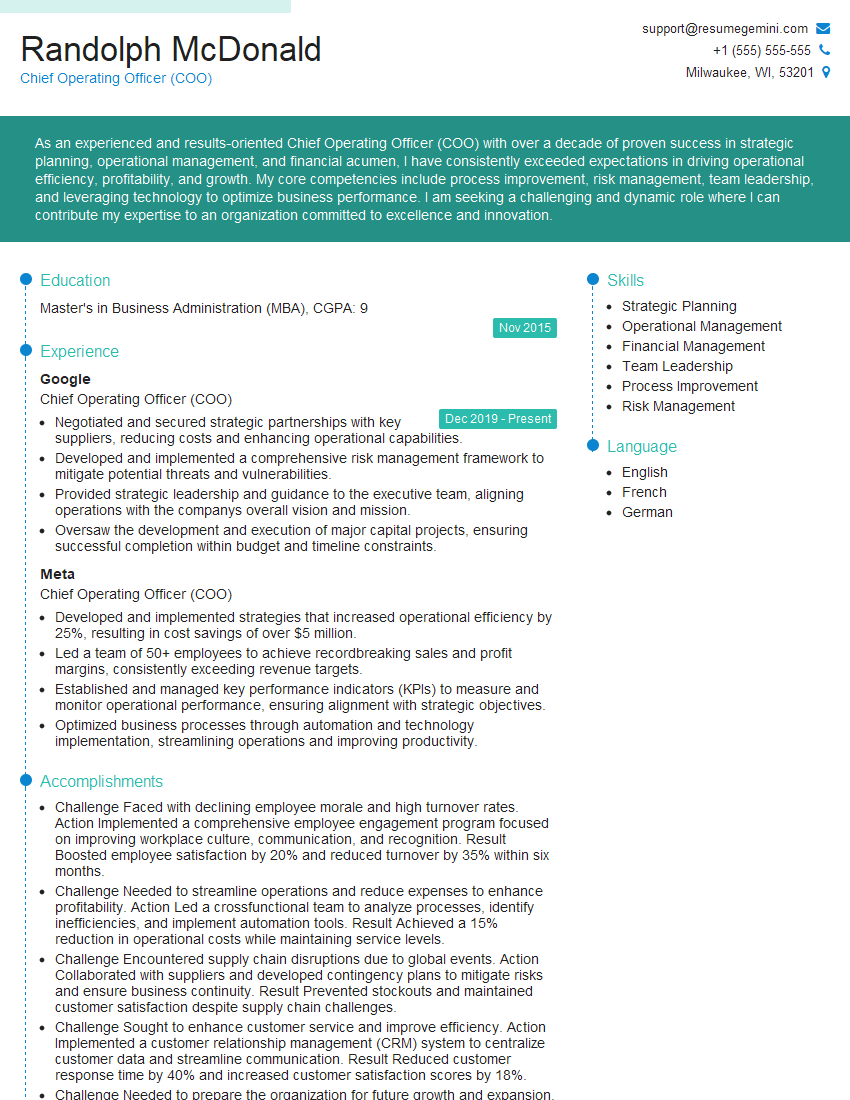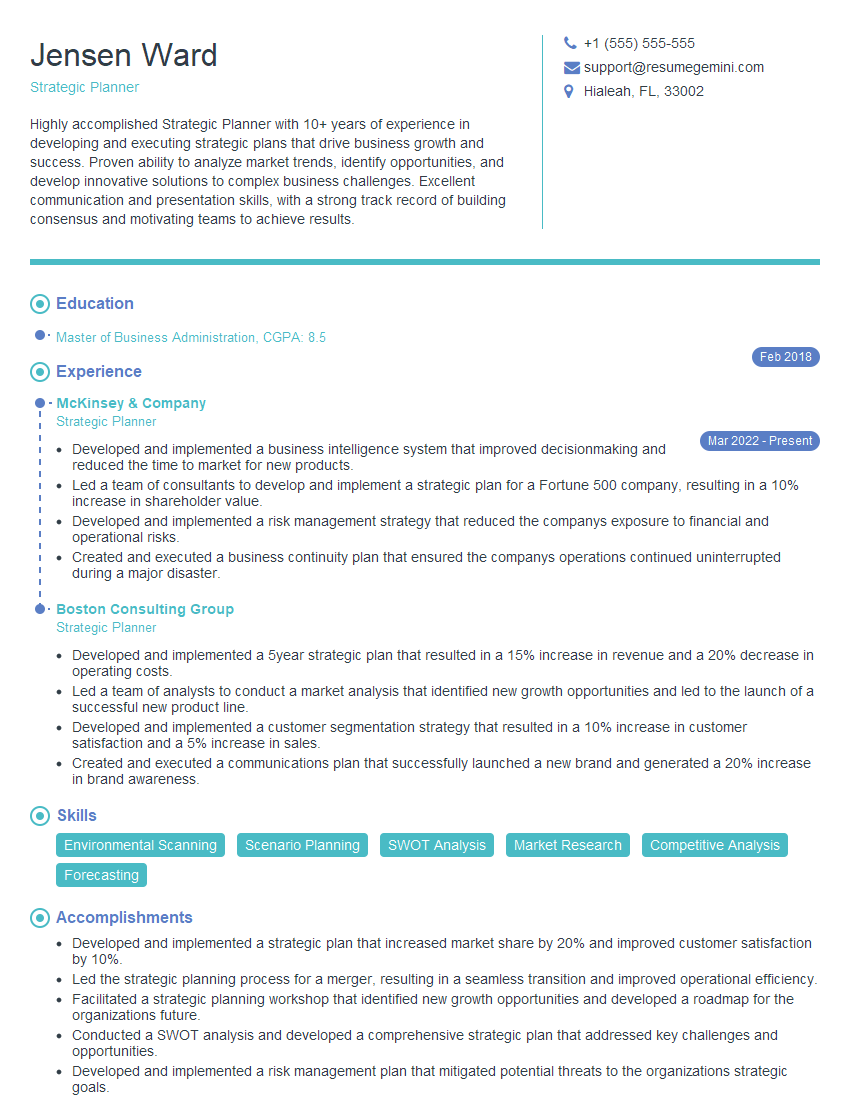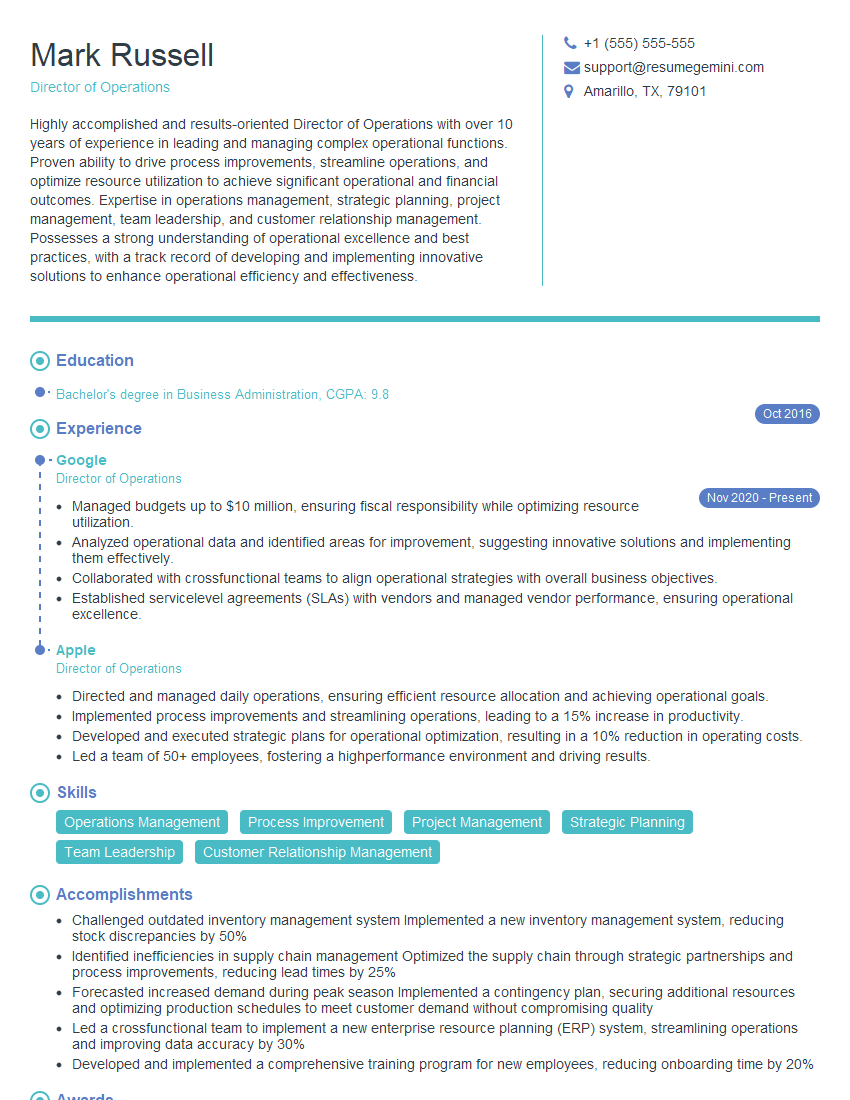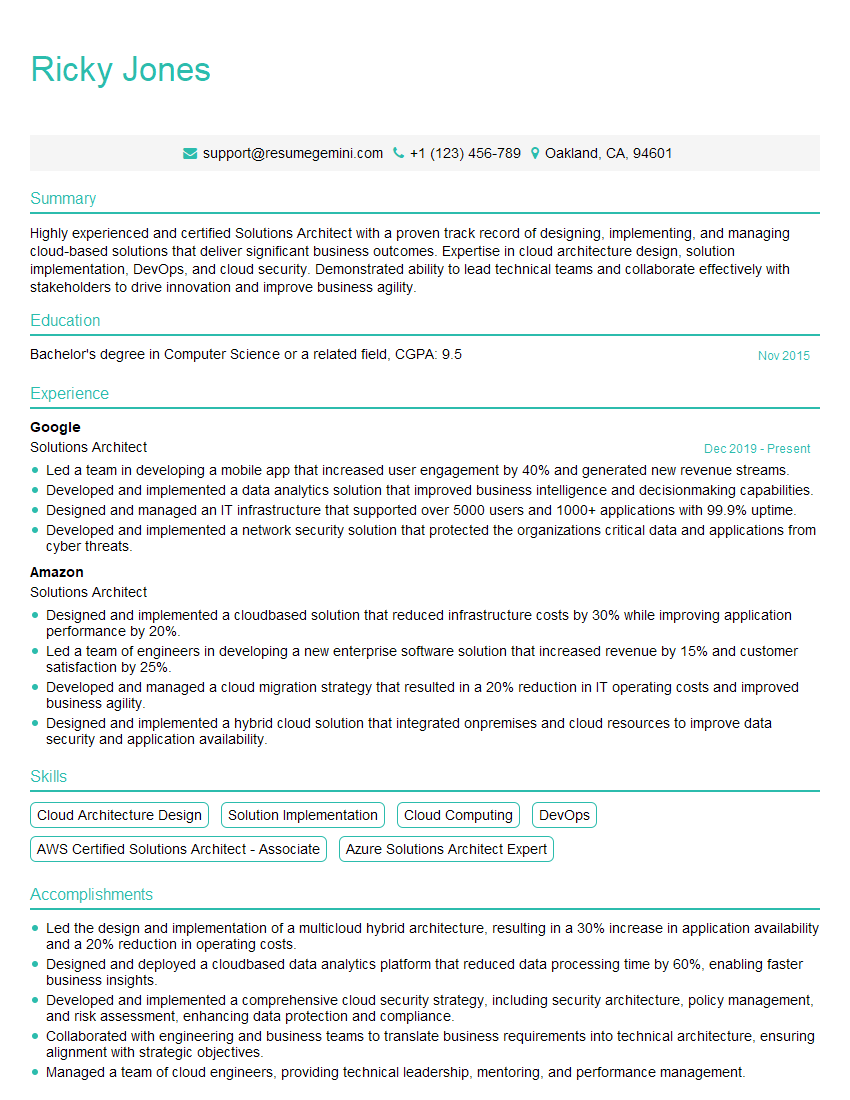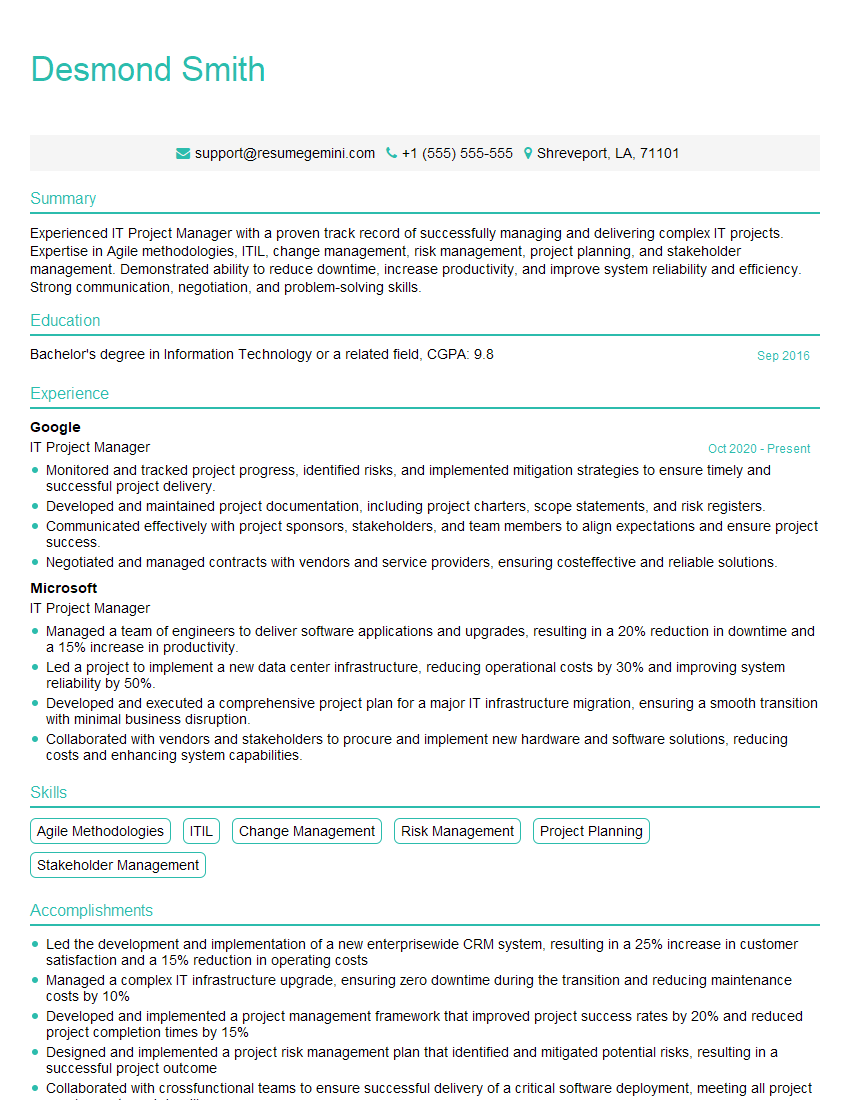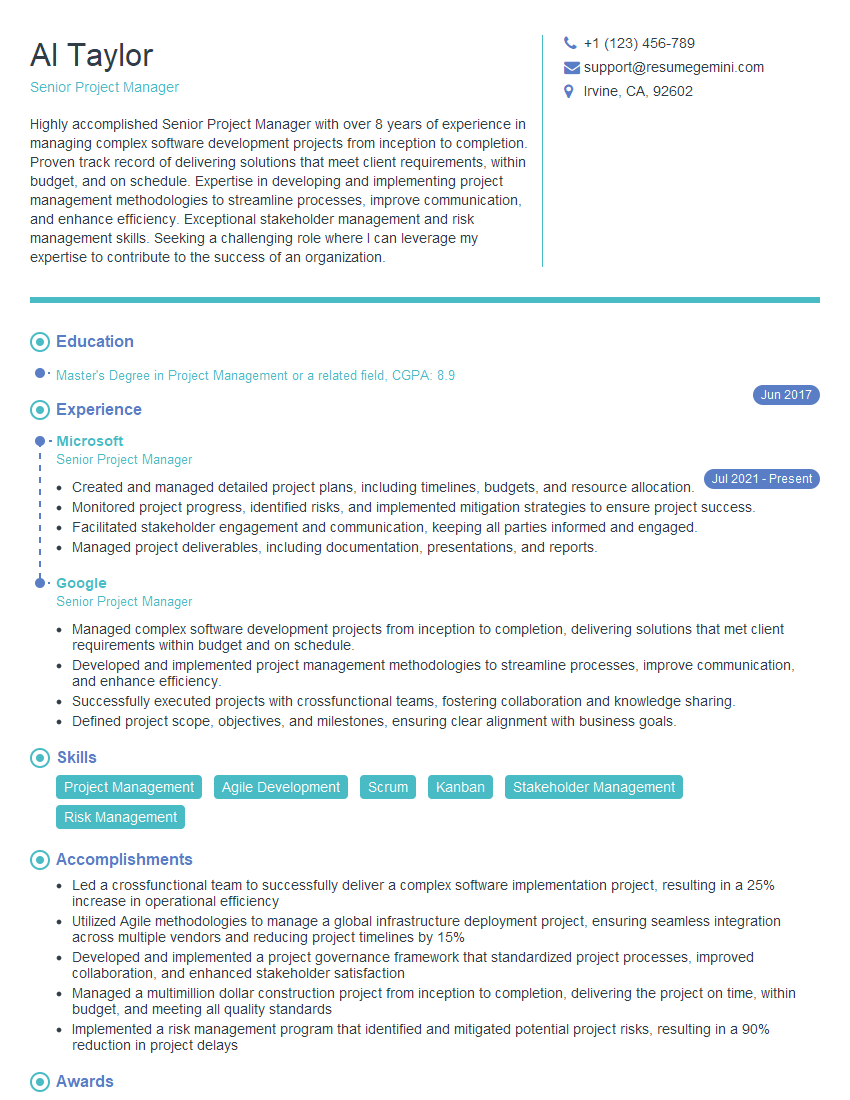The right preparation can turn an interview into an opportunity to showcase your expertise. This guide to Skill in Problem Solving and Decision Making interview questions is your ultimate resource, providing key insights and tips to help you ace your responses and stand out as a top candidate.
Questions Asked in Skill in Problem Solving and Decision Making Interview
Q 1. Describe your approach to solving a complex problem.
My approach to solving complex problems is systematic and iterative, focusing on a structured process rather than jumping to conclusions. I begin by clearly defining the problem, breaking it down into smaller, more manageable components. This involves gathering all relevant information, identifying key stakeholders, and understanding the constraints and objectives. Then, I explore potential solutions using various methods like brainstorming, root cause analysis (e.g., using the ‘5 Whys’ technique), and scenario planning. I evaluate each solution based on its feasibility, cost, and potential impact, selecting the most promising option. Implementation is followed by careful monitoring and evaluation to ensure the solution is effective and adjustments are made as needed. Think of it like building a house – you wouldn’t start laying bricks without a blueprint; similarly, a complex problem requires a well-defined plan and continuous evaluation.
For example, if faced with declining sales, I wouldn’t just assume it’s a marketing issue. I’d investigate potential causes – are prices too high? Is the product outdated? Are there supply chain problems? By breaking down the problem, I can develop targeted solutions, rather than wasting resources on ineffective strategies.
Q 2. Explain a time you had to make a difficult decision under pressure.
During a previous role, our team faced a critical software bug just days before a major product launch. The bug risked a significant financial loss and damaged our reputation. Under intense pressure, I had to decide between a quick, potentially risky fix and delaying the launch. Delaying would mean missing deadlines and losing market momentum, while a hasty fix might introduce further complications. After carefully analyzing the bug, consulting with the development team, and assessing the potential risks of both options, I opted for a phased rollout. We released a version with the critical bug fixed to a smaller user segment first, allowing us to monitor for unforeseen issues before a full-scale launch. This approach mitigated the risk, allowed us to gather real-time feedback, and ultimately resulted in a successful product launch with minimal disruption. It was a high-stakes decision, but a systematic approach and careful risk assessment allowed us to make the right choice under pressure.
Q 3. How do you prioritize competing tasks and deadlines?
Prioritizing tasks involves a combination of urgency and importance. I utilize methods such as Eisenhower Matrix (urgent/important), which helps categorize tasks into four quadrants: Do, Decide, Delegate, and Delete. This allows for focused effort on critical tasks and efficient delegation or elimination of less impactful ones. I also consider dependencies – tasks that need to be completed before others can begin. Project management tools with features like Gantt charts and Kanban boards are incredibly helpful in visualizing deadlines and dependencies, making prioritization clearer and more manageable. It’s about strategic allocation of time and resources to maximize efficiency and achieve the most significant outcomes.
- Urgent and Important: Address immediately (e.g., crisis management).
- Important but Not Urgent: Schedule for later (e.g., strategic planning).
- Urgent but Not Important: Delegate (e.g., minor administrative tasks).
- Neither Urgent nor Important: Eliminate (e.g., time-wasting activities).
Q 4. Walk me through your decision-making process.
My decision-making process follows a structured approach: First, I clearly define the problem or decision. Then, I gather information from various sources, seeking diverse perspectives to avoid bias. Next, I identify and evaluate potential options, analyzing the pros and cons of each. This involves considering potential risks and consequences, using both quantitative and qualitative data. I weigh the options based on established criteria, aligning them with overall objectives. I then choose the best option, clearly documenting the rationale for my decision. Finally, I implement the chosen option and carefully monitor the results, making adjustments as needed. This iterative process allows for continuous learning and improvement in future decision-making.
Q 5. How do you identify and analyze potential risks in a project?
Identifying and analyzing potential risks in a project requires a proactive and systematic approach. I often use risk assessment matrices that involve identifying potential risks, assessing their likelihood and impact, and then developing mitigation strategies. This might involve brainstorming sessions with the team, reviewing historical data from similar projects, or consulting with subject matter experts. The likelihood and impact are typically rated on a scale (e.g., low, medium, high), allowing for prioritization of the most critical risks. Mitigation strategies can include developing contingency plans, allocating additional resources, or implementing risk-reducing procedures. Regular monitoring and review of identified risks are crucial, as new risks might emerge throughout the project lifecycle.
Q 6. How do you approach a problem when you lack all the necessary information?
When lacking complete information, I employ a multi-pronged approach. Firstly, I identify the missing information and prioritize obtaining it. This might involve research, data analysis, seeking input from relevant stakeholders or experts, or conducting surveys. Simultaneously, I analyze the available information to make informed estimations and educated guesses, acknowledging the uncertainties involved. I might explore multiple scenarios based on different assumptions about the missing data. This allows for developing robust solutions that can adapt to different possibilities. Transparency is crucial; I clearly communicate the limitations of the decision due to incomplete information to relevant stakeholders, ensuring shared understanding and managing expectations.
Q 7. Describe a time you had to make a decision with incomplete data.
In a previous project, we had to decide on a marketing campaign with limited data on our target audience’s preferences. We had some demographic information, but lacked detailed psychographic data. Instead of waiting for perfect data (which might have been impossible to obtain), we developed a phased campaign, starting with a smaller-scale pilot program to gather real-time feedback and adjust our strategies accordingly. This allowed us to test different messaging and creative approaches, refine our targeting based on initial results, and improve the campaign’s effectiveness over time. While the initial data was incomplete, this iterative approach minimized the risk of a complete failure and allowed us to make informed decisions based on evolving insights.
Q 8. How do you handle disagreements or conflicts within a team?
Disagreements are inevitable in teamwork, but they can be opportunities for growth and innovation. My approach centers around fostering open communication and collaborative problem-solving. I believe in active listening – truly hearing all perspectives before forming an opinion. I encourage team members to articulate their viewpoints clearly and respectfully, focusing on the issue at hand rather than resorting to personal attacks.
If the disagreement stems from differing opinions, I facilitate a structured discussion using techniques like brainstorming to explore various solutions. We might weigh pros and cons, prioritize objectives, and ultimately reach a consensus through collaborative decision-making. If the disagreement is rooted in a misunderstanding, clarification and open dialogue are key to resolving it. In rare cases, if a compromise can’t be reached, I might involve a mediator or higher management for impartial guidance. The goal is always a constructive outcome that leaves all team members feeling heard and respected.
Q 9. How do you measure the success of a decision?
Measuring the success of a decision isn’t a one-size-fits-all process; it depends heavily on the context and objectives. A crucial first step is defining clear, measurable goals *before* making the decision. These goals should be SMART – Specific, Measurable, Achievable, Relevant, and Time-bound. For example, instead of saying “improve customer satisfaction,” a SMART goal might be “increase customer satisfaction scores by 15% within the next quarter, as measured by our monthly customer feedback surveys.”
Once the decision is implemented, we track key performance indicators (KPIs) related to those goals. These KPIs could include sales figures, customer satisfaction scores, project completion rates, or any other metrics relevant to the decision’s impact. We regularly analyze the data to assess the effectiveness of the decision. A successful decision will demonstrably move us closer to our defined goals. However, it’s also vital to acknowledge when a decision isn’t yielding the expected results and be prepared to adapt or even reverse course.
Q 10. Describe a time you had to change your approach to solving a problem.
During a software development project, we initially adopted an agile methodology with daily stand-ups and short sprints. While initially effective, we encountered significant challenges integrating newly acquired functionalities from a third-party vendor. The short sprints and daily stand-ups, while promoting flexibility, hindered effective communication and coordination with the external vendor who operated on a different timeline.
Recognizing the problem, I proposed a shift in approach. We transitioned to longer development cycles, focusing on broader feature sets within each cycle. We also introduced more formal communication channels and joint planning sessions with the vendor. This revised approach significantly improved collaboration, reduced integration issues, and ultimately led to a more successful project launch. The key was recognizing the limitations of our initial strategy and adapting to the specific constraints of the project.
Q 11. How do you stay organized when managing multiple projects?
Managing multiple projects requires a robust organizational system. I rely heavily on project management tools like Asana or Jira to track tasks, deadlines, and dependencies across all projects. These tools allow me to create detailed project plans, assign tasks to team members, and monitor progress visually. I also use a color-coded system to prioritize tasks based on urgency and importance, ensuring that time-sensitive projects receive the necessary attention.
Beyond digital tools, I find that regular time blocking and prioritization are crucial. I dedicate specific blocks of time to focused work on particular projects, minimizing distractions. Prioritization helps me concentrate on the most critical tasks first, maximizing efficiency. Finally, regular review meetings, both for individual projects and for overall project portfolio management, are essential to ensure alignment and address any potential roadblocks.
Q 12. How do you use data to inform your decision-making?
Data is the cornerstone of informed decision-making. My approach involves three key steps: data collection, data analysis, and data interpretation. First, I identify the relevant data sources and collect the necessary information. This might involve reviewing sales figures, customer feedback surveys, market research reports, or internal performance metrics.
Next, I utilize analytical techniques to process and interpret the data. This could include creating charts, graphs, or statistical models to identify trends, patterns, and correlations. Tools like Excel, SQL, or specialized business intelligence software are frequently employed. Finally, I carefully interpret the findings, considering the context and limitations of the data. I strive to avoid biases and focus on evidence-based conclusions. This data-driven approach allows me to make more objective and effective decisions.
Q 13. Give an example of a time you used critical thinking to solve a problem.
Our team faced a significant challenge when a key component of our software failed unexpectedly during a critical testing phase. Initial troubleshooting efforts pointed toward a hardware issue, but the problem persisted even after replacing the hardware. Instead of relying on immediate, surface-level solutions, I employed critical thinking.
I systematically reviewed the system logs, application code, and network configurations, looking for patterns or anomalies. I questioned assumptions, exploring alternative explanations for the failure. This meticulous investigation revealed a software bug interacting unexpectedly with a specific network configuration, causing the component failure. By methodically eliminating possibilities and identifying the root cause through careful analysis, we resolved the problem effectively and prevented a major system failure.
Q 14. Describe a situation where you had to adapt to changing circumstances.
During the initial phases of a product launch, we encountered unexpected delays due to regulatory changes. Our initial marketing plan, meticulously crafted months prior, was no longer aligned with the new regulations. Adapting quickly was crucial to prevent a loss in momentum.
Rather than panicking, I facilitated a brainstorming session with the team to explore alternative strategies. We re-evaluated our marketing channels, focusing on digital platforms where the regulatory changes had less impact. We also adjusted the messaging to comply with the new rules. This agile response allowed us to launch successfully, albeit with a modified approach, minimizing the negative impact of the unexpected regulatory changes. The key was to accept the change, reassess the situation, and actively seek adaptable solutions.
Q 15. How do you balance creativity and logic in your problem-solving approach?
Balancing creativity and logic in problem-solving is crucial for achieving optimal results. It’s not about choosing one over the other, but rather integrating them. Logic provides the structure and framework, while creativity fuels innovation and exploration of unconventional solutions.
Logic involves systematic thinking, data analysis, and adherence to established principles. It ensures a structured approach, minimizing errors and maximizing efficiency. For example, using a decision tree to analyze different scenarios and their potential outcomes exemplifies a logical approach.
Creativity, on the other hand, involves thinking outside the box, exploring unconventional ideas, and generating innovative solutions. It allows for flexibility and adaptability when facing complex or ambiguous problems. For instance, brainstorming sessions or using lateral thinking techniques to find unconventional solutions demonstrates creativity.
In practice, I often start with a logical approach, defining the problem, gathering data, and establishing parameters. Then, I leverage creativity to explore different approaches and generate innovative solutions. Finally, I use logic to evaluate these solutions against established criteria and select the most appropriate one.
Career Expert Tips:
- Ace those interviews! Prepare effectively by reviewing the Top 50 Most Common Interview Questions on ResumeGemini.
- Navigate your job search with confidence! Explore a wide range of Career Tips on ResumeGemini. Learn about common challenges and recommendations to overcome them.
- Craft the perfect resume! Master the Art of Resume Writing with ResumeGemini’s guide. Showcase your unique qualifications and achievements effectively.
- Don’t miss out on holiday savings! Build your dream resume with ResumeGemini’s ATS optimized templates.
Q 16. Explain your experience with using different problem-solving frameworks (e.g., SWOT, PESTLE).
I have extensive experience utilizing various problem-solving frameworks, including SWOT, PESTLE, and the Five Whys. These frameworks offer structured approaches to analyzing problems and identifying potential solutions.
- SWOT analysis (Strengths, Weaknesses, Opportunities, Threats) helps in assessing internal capabilities and external factors that impact a situation. For instance, when launching a new product, a SWOT analysis helps identify market opportunities and potential threats from competitors.
- PESTLE analysis (Political, Economic, Social, Technological, Legal, Environmental) provides a comprehensive overview of the macro-environmental factors that could influence a problem or decision. This is particularly useful for strategic planning and risk assessment. For example, when considering expansion into a new market, a PESTLE analysis would identify political risks, economic stability, and social trends.
- Five Whys is a simple yet powerful technique for identifying the root cause of a problem by repeatedly asking ‘Why?’ until the underlying issue is uncovered. This iterative questioning helps to move beyond superficial symptoms and address the core problem. For instance, if a project is delayed, repeatedly asking ‘Why?’ might uncover issues with resource allocation or inadequate planning.
My choice of framework depends on the nature and complexity of the problem. For straightforward issues, the Five Whys might suffice; however, for strategic decisions with many variables, a PESTLE or SWOT analysis is more appropriate.
Q 17. How do you identify root causes of problems?
Identifying the root cause of a problem requires a systematic approach that moves beyond surface-level symptoms. I typically employ a combination of techniques, including the ‘Five Whys’ and root cause analysis diagrams such as fishbone diagrams (Ishikawa diagrams).
The Five Whys, as mentioned earlier, involves repeatedly asking ‘Why?’ to drill down to the core issue. This iterative process helps uncover the underlying causes hidden beneath superficial symptoms.
A fishbone diagram provides a visual representation of the potential causes contributing to a problem. It categorizes causes into main branches (e.g., people, methods, materials, environment) and then further subdivides these branches to identify contributing factors. This helps identify multiple contributing factors and not just a single root cause.
In addition to these techniques, I leverage data analysis and critical thinking to identify patterns and correlations that might reveal the root cause. The process often involves gathering information from various sources, interviewing stakeholders, and analyzing data to pinpoint the underlying problem.
Q 18. How do you communicate complex information to different audiences?
Communicating complex information effectively requires tailoring the message to the audience’s knowledge and understanding. I adjust my communication style and choose appropriate channels to ensure clarity and comprehension.
For technical audiences, I use precise language, technical jargon (when appropriate and defined), and data-driven presentations. For non-technical audiences, I focus on simplifying complex information, using analogies, visualizations (graphs, charts), and storytelling to make the message more engaging and accessible.
Choosing the right communication channel is also crucial. For instance, a detailed report might be suitable for a formal audience, while a concise email or presentation might be better for a quick update. I always prioritize clarity and conciseness, ensuring the audience understands the key takeaways.
For example, when explaining a complex technical issue to senior management, I would focus on the high-level impact and implications rather than the technical details. Conversely, when explaining the same issue to a technical team, I would delve into the specifics and technical solutions.
Q 19. How do you evaluate different options and select the best course of action?
Evaluating different options and choosing the best course of action involves a structured approach combining quantitative and qualitative factors. I typically use a decision matrix to systematically compare options based on predefined criteria.
First, I define clear selection criteria aligned with the overall goals. These criteria might include cost, feasibility, risk, time constraints, and ethical considerations. Then, I assign weights to these criteria, reflecting their relative importance. This weighted scoring helps prioritize the criteria in the decision-making process.
Next, I evaluate each option against the defined criteria, assigning scores based on their performance. Finally, I calculate a weighted average score for each option. This allows for a quantitative comparison, highlighting the option with the highest overall score. However, quantitative data alone is not sufficient. Qualitative factors such as potential risks, ethical considerations and long term implications are also carefully evaluated.
This process is not purely analytical; it involves critical thinking, considering potential risks and uncertainties, and anticipating potential consequences. Ultimately, the best course of action balances the quantitative analysis with qualitative judgments to achieve the most desirable outcome.
Q 20. Describe a time you had to make a difficult ethical decision.
In a previous project, I faced an ethical dilemma involving the release of a product with a minor but detectable flaw. While the flaw didn’t significantly impact functionality, it violated a company policy related to product quality. The deadline was tight, and releasing the product on time was crucial for meeting a critical client commitment.
My initial inclination was to prioritize meeting the deadline, but I knew that releasing a product that didn’t fully meet our standards was ethically questionable. I discussed the issue with my team and manager, outlining the potential risks and ethical implications. We explored alternative solutions, including a short delay to rectify the issue and transparent communication with the client.
Ultimately, we decided to inform the client about the minor flaw and propose a revised timeline to address it. While this decision resulted in a minor delay, it upheld our commitment to ethical conduct and maintained client trust. This experience reinforced my belief that ethical considerations should always be prioritized, even when facing pressure to meet deadlines or achieve business targets.
Q 21. How do you deal with setbacks or failures in your problem-solving efforts?
Setbacks and failures are inevitable in problem-solving. I view them as opportunities for learning and improvement. My approach involves a structured process to analyze what went wrong, identify areas for improvement, and adjust my approach accordingly.
Firstly, I conduct a thorough post-mortem analysis to identify the causes of the failure. This includes reviewing decisions made, assessing the accuracy of assumptions, and identifying any unforeseen circumstances. I use tools like root cause analysis diagrams to understand the contributing factors.
Secondly, I focus on learning from the mistakes. This involves reflecting on my own actions, seeking feedback from others, and identifying areas where my approach could have been improved. I document these lessons learned to avoid repeating the same mistakes in the future.
Finally, I adapt my approach and strategies based on the lessons learned. This might involve refining my problem-solving process, adopting new tools or techniques, or seeking additional expertise. The goal is not to avoid failures altogether, but to learn from them and become a more effective problem-solver.
Q 22. How do you ensure your decisions align with organizational goals?
Aligning decisions with organizational goals is paramount for success. It’s not just about doing your job; it’s about contributing to the overall vision. I achieve this through a three-pronged approach:
- Understanding the Big Picture: I proactively seek a deep understanding of the company’s strategic objectives, mission, and values. This involves actively reviewing strategic plans, attending relevant meetings, and engaging with leadership to clarify any ambiguities.
- Connecting Decisions to Goals: Before making any significant decision, I explicitly consider how it will impact the achievement of organizational goals. I ask myself: “Does this decision support our strategic priorities? Will it enhance efficiency? Will it improve our market position?” I document these considerations to ensure transparency and accountability.
- Regular Check-ins and Feedback Loops: I don’t operate in a vacuum. I regularly check in with my manager and team to ensure our decisions remain aligned with the overall strategy. This includes seeking feedback on my proposed solutions and adapting my approach as needed. It’s a continuous process of refinement and alignment.
For example, in a previous role, our company aimed to increase market share by 15% within the year. When faced with a resource allocation decision, I prioritized projects directly contributing to that goal, forgoing less impactful initiatives, even if tempting. This focused approach ensured our resources were optimally used toward achieving the overall strategic objective.
Q 23. How do you learn from your mistakes and improve your decision-making?
Learning from mistakes is crucial for continuous improvement in decision-making. I employ a structured approach that goes beyond simple reflection:
- Honest Self-Assessment: After every significant decision, I take time to objectively evaluate the outcome. Did it achieve the desired result? If not, why not? What were the contributing factors? I avoid assigning blame but instead focus on identifying systemic issues or personal biases that may have played a role.
- Data Analysis: When possible, I use data to analyze the effectiveness of my decisions. This helps quantify the impact and provides concrete evidence for future adjustments. For example, A/B testing different approaches can provide valuable insights.
- Seeking Feedback: I actively seek feedback from colleagues, superiors, and even those affected by the decision. Different perspectives can illuminate blind spots and provide valuable insights I might have missed.
- Documentation and Knowledge Sharing: I document my decision-making process, including the rationale, potential risks, and outcomes. This allows me to learn from both successes and failures and share this knowledge with the team to prevent future repetition of mistakes. This could include creating a formal post-mortem report for significant projects.
For instance, in a previous project, a decision to launch a marketing campaign earlier than planned proved unsuccessful due to insufficient market research. Through data analysis and feedback from the sales team, I learned the importance of thorough market validation before major launches, a lesson I’ve since integrated into my decision-making process.
Q 24. Describe a time you had to innovate to solve a problem.
Innovation is essential in problem-solving. One instance involved streamlining our customer onboarding process. We were experiencing high customer churn due to a complicated and time-consuming onboarding system. The existing system relied on multiple manual steps and different departments, leading to delays and customer frustration.
To solve this, I proposed and implemented a fully automated onboarding system using a combination of workflow automation software and interactive tutorials. This involved:
- Identifying pain points: We analyzed customer feedback and internal process bottlenecks to pinpoint areas for improvement.
- Exploring potential solutions: We researched different workflow automation tools and evaluated their suitability to our needs.
- Developing a prototype: We created a prototype of the new system and tested it with a small group of customers.
- Implementing the solution: After successful testing, we implemented the new system company-wide.
The result was a significant reduction in customer churn and a considerable increase in customer satisfaction. This involved a paradigm shift from a manual, fragmented process to a streamlined, automated system – a clear example of innovative problem-solving.
Q 25. How do you build consensus among team members when making decisions?
Building consensus involves more than simply getting everyone to agree; it’s about fostering a collaborative environment where everyone feels heard and valued. My approach relies on several key strategies:
- Open Communication: I create a safe space for open dialogue by actively encouraging all team members to share their perspectives, concerns, and ideas.
- Active Listening: I prioritize active listening, seeking to understand each individual’s viewpoint before offering my own. This demonstrates respect and builds trust.
- Collaborative Brainstorming: We engage in collaborative brainstorming sessions to generate a wide range of potential solutions. This encourages creativity and ensures that all ideas are considered.
- Data-Driven Decision Making: Using data and objective metrics helps to mitigate biases and focus discussions on concrete evidence, making it easier to reach a common understanding.
- Compromise and Negotiation: Building consensus often requires compromise. I facilitate negotiation to find solutions that address the needs and concerns of all stakeholders.
For example, during a product launch, team members had conflicting opinions on the marketing strategy. By facilitating a structured discussion with data illustrating market trends, we were able to reach a consensus on a strategy that incorporated elements from each perspective, leading to a successful launch.
Q 26. How do you use technology to improve your problem-solving and decision-making skills?
Technology plays a vital role in enhancing problem-solving and decision-making. I leverage various tools and techniques to improve my efficiency and effectiveness:
- Data Visualization Tools: Tools like Tableau or Power BI allow me to visually represent complex data, making it easier to identify trends, patterns, and potential problems.
- Project Management Software: Platforms like Asana or Jira help in organizing tasks, tracking progress, and facilitating collaboration among team members.
- Collaboration Platforms: Tools like Slack or Microsoft Teams enable seamless communication and information sharing, crucial for efficient teamwork and decision-making.
- AI-powered tools: AI-powered tools can assist in data analysis, predictive modeling, and even automated decision-making in certain contexts.
- Decision Support Systems: Sophisticated software can assist with evaluating options, forecasting outcomes, and simulating various scenarios to aid in better decision-making.
For instance, using data visualization tools, I was able to identify a correlation between a specific marketing campaign and customer acquisition costs, allowing us to optimize our budget and improve return on investment.
Q 27. Describe a time you used a data-driven approach to solve a problem.
A data-driven approach is essential for making informed and effective decisions. In a previous project involving website optimization, we observed a significant drop in conversion rates. Instead of relying on assumptions, we employed a data-driven approach:
- Data Collection: We gathered data from various sources including Google Analytics, website server logs, and customer feedback forms.
- Data Analysis: We analyzed the data to identify potential causes for the drop in conversion rates. We focused on website traffic sources, bounce rates, time spent on pages, and user behavior patterns.
- Hypothesis Generation: Based on the data analysis, we generated several hypotheses, such as problems with the website design, confusing navigation, or slow page loading times.
- Testing and Iteration: We designed and implemented A/B tests to test our hypotheses. For example, we tested different website layouts and call-to-action buttons.
- Evaluation and Optimization: We analyzed the results of our tests and made iterative improvements to the website based on the data.
Through this data-driven approach, we were able to pinpoint the exact issues causing the drop in conversion rates and implement effective solutions, resulting in a significant improvement in website performance.
Q 28. How do you delegate tasks effectively in a problem-solving context?
Effective delegation in problem-solving involves identifying the right person for the right task, providing clear expectations, and empowering them to succeed. My approach centers on these key principles:
- Task Clarity: I define tasks clearly, specifying deliverables, timelines, and relevant resources. Ambiguity leads to inefficiency and frustration.
- Skill Matching: I match tasks with team members possessing the necessary skills and experience. This ensures the task is completed effectively and efficiently.
- Empowerment and Autonomy: I empower team members by providing them with the autonomy to make decisions and solve problems within their assigned scope. This fosters ownership and accountability.
- Regular Communication and Support: I maintain open communication channels, providing regular check-ins and offering support when needed. This ensures that the tasks are progressing as planned and that any challenges are addressed promptly.
- Feedback and Recognition: I provide constructive feedback and recognize achievements, motivating team members and reinforcing positive behavior.
For instance, when tackling a complex project, I delegated specific components to different team members based on their strengths and expertise. By providing clear instructions, regular check-ins, and timely feedback, I ensured everyone was working efficiently and contributing effectively to the overall project goals.
Key Topics to Learn for Skill in Problem Solving and Decision Making Interviews
- Defining the Problem: Learn to clearly articulate the problem, gathering all necessary information and identifying the root cause, not just the symptoms.
- Analytical Thinking & Critical Evaluation: Practice breaking down complex problems into smaller, manageable parts. Develop your ability to critically evaluate information and identify biases.
- Solution Generation & Evaluation: Explore various potential solutions, weighing the pros and cons of each using a structured approach (e.g., cost-benefit analysis, risk assessment).
- Decision-Making Frameworks: Familiarize yourself with decision-making models like the DECIDE model or SWOT analysis to demonstrate a structured approach to problem-solving.
- Communication & Collaboration: Practice effectively communicating your thought process, justifying your decisions, and collaborating with others to achieve a common goal.
- Practical Application: Use the STAR method (Situation, Task, Action, Result) to structure your responses and showcase your problem-solving skills through real-world examples from previous experiences.
- Adaptability & Resilience: Demonstrate your ability to adapt to changing circumstances and persevere through challenges, showing a growth mindset.
- Ethical Considerations: Understand the ethical implications of your decisions and demonstrate responsible decision-making.
Next Steps
Mastering problem-solving and decision-making skills is crucial for career advancement. Employers highly value candidates who can effectively analyze situations, generate creative solutions, and make sound judgments. To significantly enhance your job prospects, focus on building an ATS-friendly resume that clearly highlights these skills. ResumeGemini is a trusted resource to help you create a professional and impactful resume that showcases your abilities. We provide examples of resumes tailored to emphasize skills in problem-solving and decision-making, helping you present your qualifications effectively to potential employers.
Explore more articles
Users Rating of Our Blogs
Share Your Experience
We value your feedback! Please rate our content and share your thoughts (optional).
What Readers Say About Our Blog
Hello,
We found issues with your domain’s email setup that may be sending your messages to spam or blocking them completely. InboxShield Mini shows you how to fix it in minutes — no tech skills required.
Scan your domain now for details: https://inboxshield-mini.com/
— Adam @ InboxShield Mini
Reply STOP to unsubscribe
Hi, are you owner of interviewgemini.com? What if I told you I could help you find extra time in your schedule, reconnect with leads you didn’t even realize you missed, and bring in more “I want to work with you” conversations, without increasing your ad spend or hiring a full-time employee?
All with a flexible, budget-friendly service that could easily pay for itself. Sounds good?
Would it be nice to jump on a quick 10-minute call so I can show you exactly how we make this work?
Best,
Hapei
Marketing Director
Hey, I know you’re the owner of interviewgemini.com. I’ll be quick.
Fundraising for your business is tough and time-consuming. We make it easier by guaranteeing two private investor meetings each month, for six months. No demos, no pitch events – just direct introductions to active investors matched to your startup.
If youR17;re raising, this could help you build real momentum. Want me to send more info?
Hi, I represent an SEO company that specialises in getting you AI citations and higher rankings on Google. I’d like to offer you a 100% free SEO audit for your website. Would you be interested?
Hi, I represent an SEO company that specialises in getting you AI citations and higher rankings on Google. I’d like to offer you a 100% free SEO audit for your website. Would you be interested?
good
